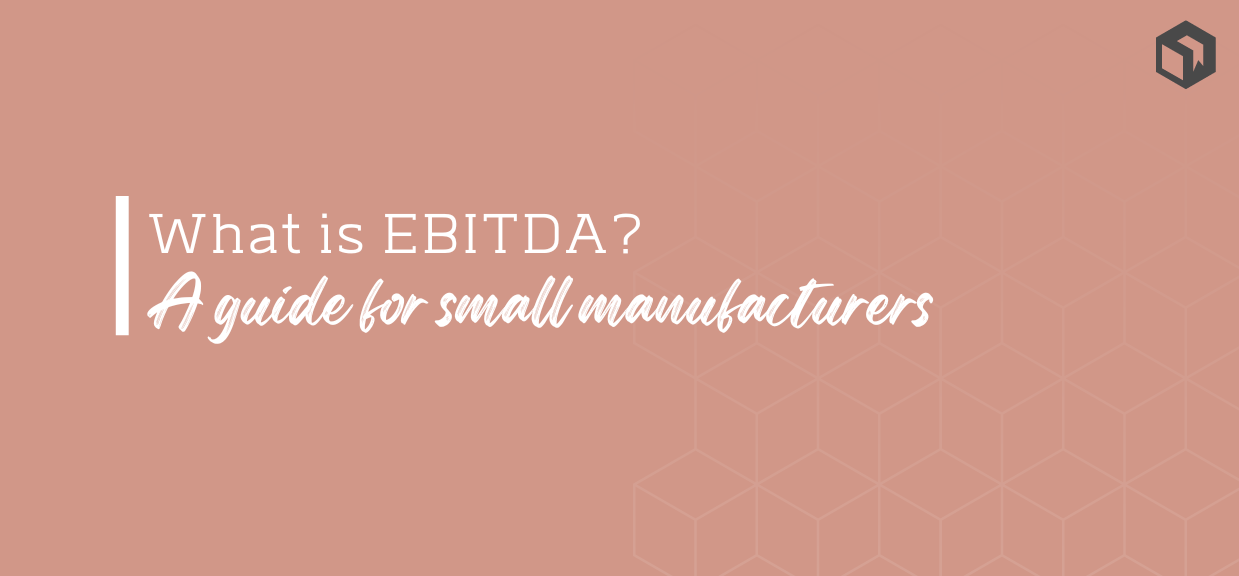What is EBITDA? A Guide for Small Manufacturing Businesses
Wondering about EBITDA and how it impacts your small manufacturing business? Our article will guide you through what it means and what a good EBITDA is for your industry.

When measuring a manufacturing business’s profitability, EBITDA is often cited as a key metric to track. It’s wise to be aware of what it means, and how it can be best measured and incorporated into your small manufacturing business.
This article will discuss what EBITDA is and how it can be calculated. We’ll also look at what a good EBITDA margin for manufacturing businesses actually is, so you can see how you currently measure up.
Need to get your raw material and product inventory under control?
Try Craftybase - the inventory and manufacturing solution for DTC sellers. Track raw materials and product stock levels (in real time!), COGS, shop floor assignment and much more.
It's your new production central.
Let’s begin!
What is EBITDA?
EBIT(DA) is, in a nutshell, your earnings before interest and taxes are factored in.
EBITDA stands for:
Earnings Before Interest
Taxes
Depreciation, and
Amortization
EBITDA gives a good, high-level indication of a company’s overall financial health. It’s a way of measuring a company’s profitability, by attempting to strip out any one-time or non-operational items that could skew the results.
Because it strips out the unique costs of your particular operations, EBITDA can be used to compare companies in the same industry, or even similar manufacturing companies across different industries. As it’s a less volatile calculation than net margin, it can also be used across financial years.
EBITDA margin vs EBITDA multiples
When we’re talking about EBITDA, two key metrics are often used interchangeably, but it’s important to understand the difference between them before we continue. The first is EBITDA margin, which is simply EBITDA as a percentage of revenue. This is a good way to compare companies of different sizes, as it considers the overall revenue base.
The second metric is called a EBITDA multiple, which is the ratio of a company’s market value to its EBITDA. This is often used when valuing companies for sale or investment, as it indicates how much someone is willing to pay for each dollar of earnings. We’ll be covering only EBITDA margins as part of this article, as unless you are looking to sell your business, it is of little relevance.
EBITDA vs EBIT calculations
You may have also heard of the term EBIT, or earnings before interest and taxes. This is similar to EBITDA, but it doesn’t take depreciation and amortization into account.
In general, EBITDA is a more comprehensive measurement than EBIT, as it gives a fuller picture of a company’s profitability. For manufacturing businesses in particular, depreciation can be a significant expense, so it’s important to take this into account.
How to calculate your EBITDA margin
For manufacturing companies, the EBIT calculation factors in your cost of manufacturing, including your raw materials and total operating expenses (which includes things like employee wages).
You’ll want to note that the EBIT calculation doesn’t factor in any debt or interest arising from debt, so it does tend to paint a rosier than actual picture of your operations if you have a substantial amounts of debt or are operating in an inflationary environment.
To calculate your EBITDA, you simply take your total revenue for a given period, and subtract your total expenses (excluding interest, tax, depreciation, and amortization).
This will give you your EBITDA figure. To calculate the margin, you then divide this by your total revenue and multiply by 100.
For example, let’s say your manufacturing business had revenue of $1 million in the last financial year, and total expenses (excluding interest, tax, depreciation, and amortization) of $800,000. This would give you an EBITDA figure of $200,000. Dividing this by total revenue gives you a margin of 20%.
So, what is a good EBITDA margin for manufacturing?
Now that we know how to calculate EBITDA margin, let’s take a look at what a good margin might be for manufacturing businesses. Obviously, there will be some variation depending on the size and sector of the company (which we will discuss later in this article).
Generally speaking, a good EBITDA margin for manufacturing businesses falls between 5% and 10%.
However, this will vary depending on the specific industry you are manufacturing your products for, and how capital-intensive your operations are.
For example, companies in capital-intensive industries, such as automotive manufacturing, tend to have lower EBITDA margins than those in less capital-intensive industries, such as food and beverage manufacturing.
Many other factors can further impact a company’s EBITDA margin, including the overall economic climate, competition levels, and the efficiency of the company’s operations.
Overall, a good EBITDA margin is an important indicator of a company’s financial health, but it is just one piece of the puzzle. Manufacturing businesses should focus on several different metrics to ensure long-term profitability and success.
Factors to consider when interpreting your company’s EBITDA margin
There are a number of factors that can impact your company’s EBITDA margin, so it’s important to take them into account when interpreting the results. Here are some of the key things to keep in mind:
The overall economic climate: A recessionary environment can lead to lower revenue and increased costs, impacting your EBITDA margin.
Competition levels: If your industry is highly competitive, it can put pressure on your prices and margins.
The efficiency of your company’s operations: A well-run manufacturing business, with a predictable supply chain, will be more efficient and have lower costs, which will improve its EBITDA margin.
The size of your company: Larger companies tend to have lower EBITDA margins than smaller companies.
Your company’s capital structure: The mix of debt and equity that your company has can impact your EBITDA margin. For example, companies with a higher debt level will have higher interest costs, which will reduce their EBITDA margin.
The accounting method used: The way in which your company accounts for depreciation and amortization can impact your EBITDA margin.
All of these factors should be taken into account when looking at your company’s EBITDA margin. By doing so, you’ll get a more accurate picture of your financial health and be able to identify areas where improvements can be made.
Improving your company’s EBITDA margin
There are a number of things that you can do to improve your company’s EBITDA margin. Here are some of the key areas to focus on:
Revenue growth: One of the most effective ways to improve your EBITDA margin is to grow your top line. This can be achieved through a number of different initiatives such as expanding into new markets, launching new products, or increasing your marketing efforts.
Cost reduction: Another way to improve your EBITDA margin is to reduce your costs. This can be done by improving operational efficiency, negotiating better prices with suppliers, or automating certain processes.
Capital structure: Another factor that can impact your EBITDA margin is your capital structure. If you have a higher debt level, it can increase your interest costs and reduce your margin. One way to improve this is to refinance your debt at a lower rate or convert some of it to equity.
Accounting methods: The way in which you account for depreciation and amortization can also impact your EBITDA margin. You may be able to improve your margin by changing the method that you use.
By focusing on these key areas, you can start to improve your company’s EBITDA margin. This will help to improve your financial health and position you for long-term success.
Using MRP software to improve your EBITDA

One of the best ways to improve your company’s EBITDA margin is to invest in manufacturing resource planning (MRP) software. This software can help you optimize your production process and reduce costs. In turn, this will help to improve your EBITDA margin as we’ve discussed above.
MRP software can also provide several other benefits for growing manufacturing businesses, including:
Improved efficiency: MRP software can help you to streamline your production process and make it more efficient. This will reduce your costs and improve your EBITDA margin.
Better planning: MRP software can help you to plan your production more effectively. This will allow you to avoid waste and reduce your costs, which will improve your EBITDA margin.
Increased visibility: MRP software gives you better visibility into your production process. This will allow you to identify areas where improvements can be made.
Craftybase MRP is a great option for manufacturing businesses that want to improve their EBITDA margin. It is designed to help you streamline your production process and reduce costs. In turn, this will help you to improve your bottom line.
To learn more about how Craftybase can help you to improve your EBITDA margin, take our 14 day trial today.
